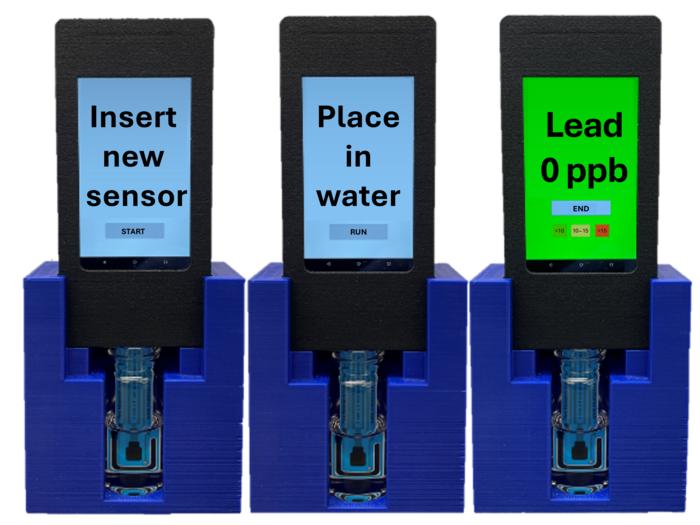In an era where environmental hazards quietly disrupt daily life, the threat posed by lead contamination in drinking water remains a critical public health challenge. Even minimal exposure to lead can cause irreversible damage to the human brain and nervous system, with children being particularly vulnerable. To confront this silent crisis head-on, scientists have pioneered a groundbreaking handheld device, termed the “E-Tongue,” aimed at democratizing water quality monitoring and empowering communities to proactively detect lead contamination within their own homes.
Lead contamination in water plagues many municipal systems despite rigorous treatment protocols. While water treatment plants efficiently remove countless contaminants, aging infrastructure—such as decades-old lead pipes and plumbing fixtures—often reintroduce hazardous lead into household water supplies. Standard laboratory analyses for lead detection demand costly equipment, expert handling, and prolonged turnaround times, creating a barrier for routine home testing. The E-Tongue technology circumvents these limitations through a user-friendly electrochemical sensing approach that grants individuals direct control over their water safety assessment.
At its core, the E-Tongue harnesses voltammetry principles, leveraging an electrode coated with gold that reacts to lead ions in water samples. When a potential voltage is applied, lead ions adhere electrochemically to the gold sensor surface. By then reversing this voltage, the sensor detaches the lead ions, generating an electrical current directly proportional to the lead concentration present. This electrochemical signal is immediately processed, allowing for near real-time quantification of lead levels, eliminating the need for offsite laboratory verification in most scenarios.
Crucially, the E-Tongue pairs seamlessly with a smartphone application designed to simplify operation and data interpretation. Users immerse the sensor in a precise mixture of tap water and buffer solution, initiating the diagnostic sequence via the app’s intuitive interface. Upon completion, the app renders lead concentration readings through color-coded alerts—a green screen assures users that lead content resides safely below the EPA’s regulatory threshold of 10 parts per billion, while a red alert signals hazardous contamination demanding immediate attention. This immediate feedback loop equips residents with critical knowledge to take informed actions.
The innovation was rigorously field-tested throughout four Massachusetts towns, engaging 317 citizen scientists in a community-driven monitoring initiative. Participants conducted 634 water quality tests, meticulously following app-guided protocols that ensured standardization despite diverse environments. Collaborative efforts between residents, scientists, and local governments facilitated a robust dataset reflecting real-world conditions, capturing spatial variations in lead contamination across municipal distribution systems.
Analytical comparisons underscored the device’s reliability: the E-Tongue’s measurements closely paralleled results from high-precision laboratory techniques, affirming its accuracy for home and community use. Within this extensive sample pool, ten water samples surpassed the EPA’s permissible limits, underscoring persistent localized contamination issues. Additionally, several samples neared these thresholds, highlighting the device’s sensitivity in identifying emerging risks before they escalate into critical health hazards.
This novel approach marks a significant advance beyond conventional water testing paradigms by emphasizing rapid, user-friendly, and cost-effective deployment. By decentralizing water quality surveillance and involving citizens directly in environmental monitoring, the technology fosters greater transparency and community engagement. Empowered with actionable data, residents can advocate for infrastructure improvements, demand timely remediation, and implement household-scale water treatment measures when necessary.
From a technical standpoint, the E-Tongue exemplifies the practical application of electrochemical sensor technology combined with mobile computing to address pressing environmental health issues. Its success validates the fusion of voltammetric sensing with geospatial data analytics, enabling not only point-of-use detection but also comprehensive community-wide mapping of water quality trends. Such integration enhances decision-making capabilities at municipal and regional levels, supporting proactive public health interventions.
Looking forward, researchers envision expanding the E-Tongue platform to detect an array of heavy metals and other pollutants, transforming it into a versatile environmental sentinel device. Continuous improvements aim to refine sensor sensitivity, streamline user experience, and integrate cloud-based analytics for long-term trend visualization. The hope is that accessible tools like this will inspire citizen empowerment worldwide, driving improved water safety standards and environmental stewardship on a global scale.
The development of the E-Tongue technology is a testament to the power of interdisciplinary collaboration, combining expertise in chemistry, environmental science, and information technology. Funded by the National Science Foundation, the project exemplifies how academic research can translate into tangible solutions that improve quality of life. Importantly, the device illustrates how innovation can bridge the gap between complex scientific methodologies and everyday practical utility.
As water quality concerns intensify with aging infrastructure and increasing environmental pressures, the E-Tongue offers a scalable and sustainable solution. By enabling individuals and communities to monitor their water’s safety with confidence and immediacy, this technology not only prevents exposure to toxic lead but also promotes health equity and environmental justice. The implications of such tools extend beyond water safety, representing a pivotal step toward greater citizen involvement in environmental health surveillance.
Ultimately, the E-Tongue serves as a beacon for future scientific advancements aimed at safeguarding public health through accessible technology. It embodies the shift towards decentralized environmental monitoring, where informed citizens become key agents in detecting and mitigating hazards. This transformation is not just technical but profoundly social, heralding a new era of community resilience powered by science and innovation.
Subject of Research: Lead contamination detection in drinking water using handheld voltammetric sensors
Article Title: “Community-Wide Monitoring of Lead in Drinking Water Distribution Systems Using Hand-Held Voltammetric Sensors and Geographic Information Systems”
News Publication Date: 1-May-2025
References: ACS Omega 2025, DOI: 10.1021/acsomega.5c01580
Image Credits: Adapted from ACS Omega 2025, DOI: 10.1021/acsomega.5c01580
Keywords: Chemistry, Public health, Water pollution, Heavy metal pollution, Sensors




